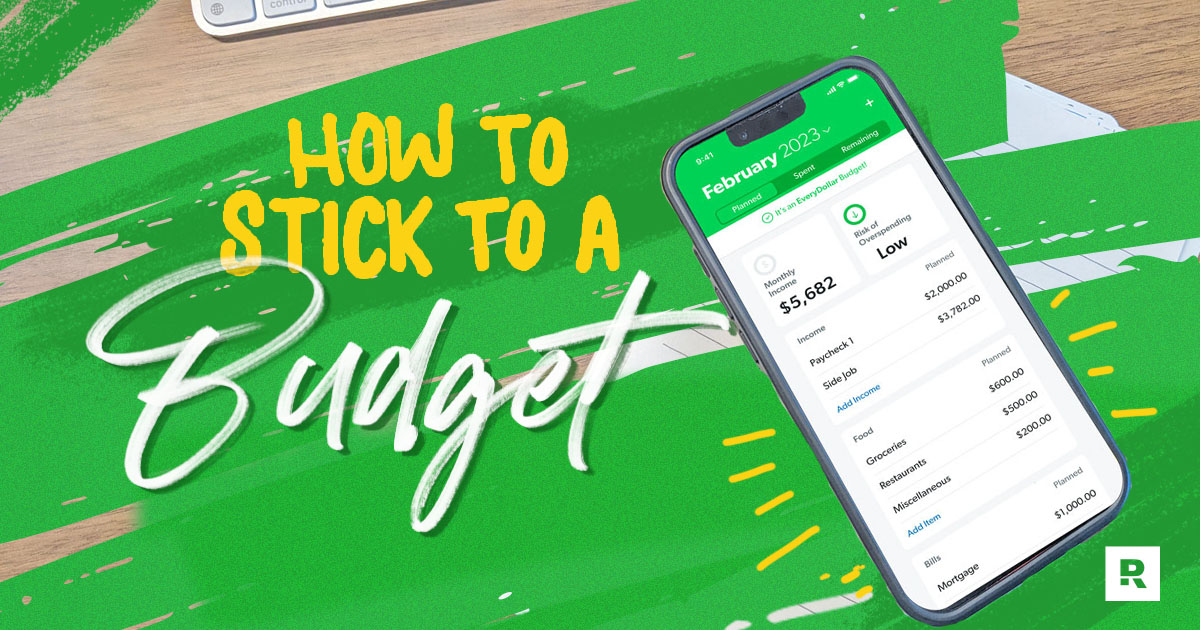
How to Make a Budget: Your Step-by-Step Guide
Learning how to budget might seem overwhelming, but hear this: You can do it. Here's how to make a budget in just five steps.
If you’ve never budgeted before—or it’s been a while—this budget calculator is a solid starting point. Type in your monthly take-home pay and get a budget example to begin.
Enter your income and the calculator will show the national averages for most budget categories as a starting point. A few of these are recommendations (like giving). Most just reflect average spending (like debt). Don't have debt? Yay! Move that money to your current money goal.
The budget calculator helps you see where you stand with your money right now. But what if your income and expenses don’t balance out? Great question. Try this:

Is there a red negative number at the bottom of your budget? Don’t freak out. This is just a wake-up call! You can get that number to zero. Just give every dollar a job—giving, saving and spending—without overspending! It’s time to make some changes. (Keep reading.)

Once you see you’re overspending, you can fix the problem! Start by cutting down your spending. What if you took up meal planning to save on groceries? Get creative and cut the fluff where you can afford to. Then lower some numbers in the calculator based on this kind of planning.

Wait, did you have money left over after typing in all your expenses? Bravo! Time to give those dollars a job—build up your savings or pay off your debt. Whatever your current money goal is, get after it!

Okay, you worked through your numbers in this budget calculator. Awesome. But don’t leave them on the screen. This is just the first step in your beautiful budgeting journey. Download EveryDollar (it’s free!) and start telling your money where to go—one monthly budget at a time.
Maybe you’re still wondering how to find your budget numbers, or you want to know how to build the best budget. Here’s even more info on the budget categories to help!
This is your take-home pay after taxes. Put in your regular paycheck plus any extra money you plan to bring in (hello, side hustle).
Be intentional about making generosity a regular part of your life. Start your budget by giving 10% of your income.
If you’re in debt, save $1,000 in a starter emergency fund. Then pause saving and focus on paying off that debt. Once you’re debt-free, save up 3–6 months of expenses for a fully funded emergency fund. These are the first three of the 7 Baby Steps, and taking each of these steps one at a time is how you make real progress with your money goals.
Food is the easiest budget line to bust—and the hardest to plan for that first month. Open your bank account and see about how much you spent on food last month. You can tweak this number in EveryDollar as you budget (and learn more about) your spending here!
Utilities are the essential expenses that keep your house running. The amounts can change, but check your bank account and see what you spent last month on electricity, water, the phone bill, natural gas, etc. Add those up and start with that number here.
Pro tip: When you spend 25% (or less) of your take-home pay on housing (mortgage or rent plus insurance, property taxes and HOA fees), one of your biggest blessings (your home) won’t turn into a financial burden.
Look back through your bank account and add up how much you spent on gas last month as a starting number for this category. Then don’t forget auto insurance, maintenance, and anything else you spend on transportation.
You planned for homeowners/renters and auto coverage in other categories. Here, add what you spend on other insurances you need: term life, health, long-term disability, long-term care (if you’re age 60+), identity theft, and umbrella (if you’ve got a net worth of $500,000 or more).
Toothpaste, shampoo, laundry supplies: How much do you spend on these things each month? This is another hard one to pin down at first—but soon you’ll be a pro here. (Not literally. No one goes pro planning toilet paper spending. Yet.)
Debt is any money you owe to anyone for any reason. So, add up all your car payments, credit card bills, student loans, medical debt and other payment plans and put that total here. Then start hustling to pay it off and really make progress with your money.
When you’re debt-free and your fully funded emergency fund is, well, fully funded, it’s time for retirement savings! Start prepping for your future by investing 15% of your income.
This is what you plan to spend on all the fun stuff: concert tickets, family trips to the ballpark, bagpipe lessons, salon visits—all those exciting extras. (Just remember, needs come before wants.)
This budget calculator has the common categories but probably doesn’t cover everything you spend money on. Put any other expenses here. When you download EveryDollar, you can customize and add in as many budget categories as you want. (Just saying.)

Learning how to budget might seem overwhelming, but hear this: You can do it. Here's how to make a budget in just five steps.

Budgets: Can't hit your goals (or fight inflation) without them. But man, it can be hard to get things just right. You know what you need? This list filled with 15 of our favorite budgeting tips.

With temptation to spend everywhere and inflation on the rise, it’s so hard to stick to a budget! But guess what? You can do this! Here are some easy ways to stay on track.